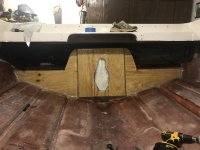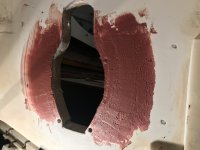Drivewayboater2
Petty Officer 1st Class
- Joined
- Aug 21, 2019
- Messages
- 337
Okay… question regarding setting the transom in with the west system epoxy. This is for a small transom section on a 1990 Bayliner 2651. It’s not a the entire transom that’s being refitted. Just the middle section. Approx 24 “ x 27”. Here’s what being replaced.
after reviewing all options I’ve come to the conclusion that the west expoy is the best way to go. considering adhesion and strength properties.
question is…. Looking at the clamping scenarios ( west systems ) encourages not to over tighten the clamping when adhering new wood to the hull. There is a bit of unevenness to the existing transom. There fore i don’t want to starve the bonding while clamping in the new transom. I get that you mix the resin with cabosil but what’s the best way to not over tighten the clamping. Yes there’s the old all thread with 2x4’s on end but is this really the way to go? saw some vids on putting pressure boards against the new transom to hold in place till cured. Any help would be appreciated.
after reviewing all options I’ve come to the conclusion that the west expoy is the best way to go. considering adhesion and strength properties.
question is…. Looking at the clamping scenarios ( west systems ) encourages not to over tighten the clamping when adhering new wood to the hull. There is a bit of unevenness to the existing transom. There fore i don’t want to starve the bonding while clamping in the new transom. I get that you mix the resin with cabosil but what’s the best way to not over tighten the clamping. Yes there’s the old all thread with 2x4’s on end but is this really the way to go? saw some vids on putting pressure boards against the new transom to hold in place till cured. Any help would be appreciated.



























